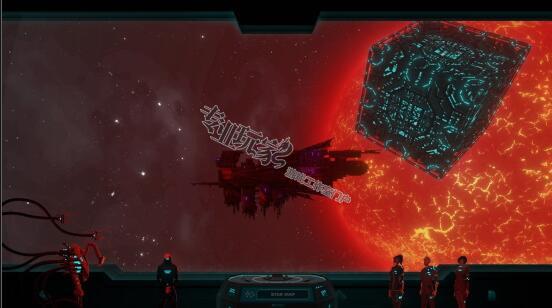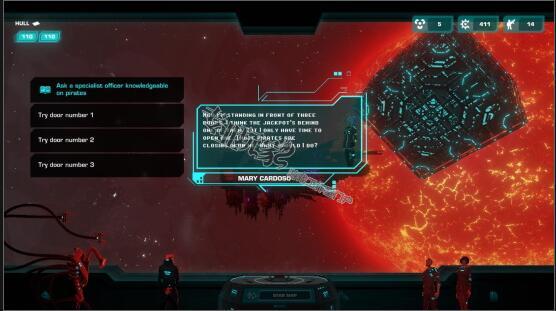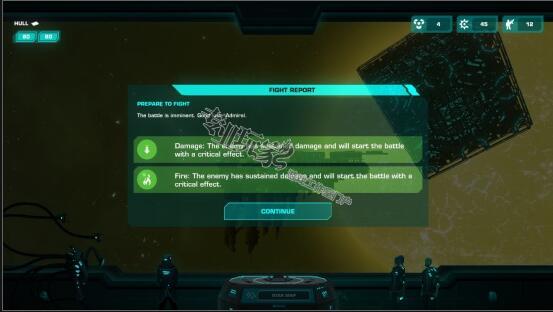游戏介绍:哭泣的太阳-值得一试
2019-09-26
1064

我不确定我是否可以说自己是流氓精英的超级粉丝,但我似乎总是在尝试他们。我想我应该注意到的是它们并不能吸引我太长时间的注意力,但我总觉得它们在表面上很有趣,值得一试。我欣赏一个好的roguelite的地方是,它在一个非常基本的系统中进行一个简单的扭曲,然后重复它,并带有一些偏差。如果做得好,这将导致具有无限可重玩性的创造性游戏。做得不好,这只是一个无聊的半心半意的游戏尝试。
我在《HumbleBundle》中扮演过很多非常有趣的流氓精英,但我也遇到过一些很烂的角色。Alt Shift最近发布了他们的《哭泣的太阳》,它吸引了我的眼球,也引起了我的兴趣,但和很多流氓多年来的做法不同,所以我决定试一试。
免费试一试
马上就有一个免费的演示。如果我不喜欢这款游戏的其他地方,我就会下载它并尝试着去做。部分原因是这对一个无赖来说是一件非常危险的事情。如果你的系统不准确和有趣,演示将花费你很多潜在的冲动销售。
不过,我非常尊重做这样的事情所需要的勇气。《哭泣的太阳》最初是在Kickstarter上发行的,仅仅一年前他们便获得了超过7.2万欧元(合8万美元)的资金来开发这款游戏。几周后他们推出了一个测试版,这对我来说意味着Kickstarter的宣传和资金一样重要。几个月后,也就是2019年2月,他们宣布与Humble Bundle建立合作关系。

在整个过程中,支持者可以提前获得beta版,但早在10月23日就向公众提供了免费演示。这距离他们在Kickstarter上成功融资还不到三个月。这也是为什么在他们宣布众筹活动时,我认为这款游戏进展良好的部分原因。
你必须对你的游戏有足够的信心才能让人们在你真正发行之前免费玩你的早期版本。我非常喜欢这类事情。那种来自新工作室的自信程度可能是危险的,但我喜欢创业者有一个好主意,并下定决心努力打破藩篱。
我在Steam上看到了这个演示并立即购买了游戏,因为这便是我想要奖励的冒险和自信。我并没有感到失望,我也不认为你会感到失望,但如果你不确定的话,你可以免费尝试这款游戏。
智能UI设计
当我开始比赛的时候,另一件让我印象深刻的事情是UI在太阳队的出色表现。它很干净,显示了所有相关的信息。UI给人一种复古的感觉,尽管它很简单,但功能仍然很强大。
UI有四个主要版本。太空战(我将在下面详细讨论),行星表面任务,地图,以及你的常规飞船操作。每个ui中都有不同的活动,还有一些其他的ui更具有过渡性,但这就是我将在本文中重点介绍的四个ui。

你花了大部分时间在桥上的美妙有很多原因,最直接和最明显的原因是通过背景中的主要观众华丽的景色。它几乎占据了整个屏幕,虽然在某种意义上它似乎是在浪费空间,但它在很多方面承载着游戏。每一个新系统,每一颗新行星,每一次相遇都以一个令人难以置信的场景视觉介绍开始。我在游戏中遇到的第一个场景就是在一个巨大的红星前完成过渡,这一场景立刻让我想起了《神秘博士》(Doctor Who)中《世界末日》(the End of the World)中同样强大的视觉效果。罗斯和医生透过大窗户观看地球残骸飘过的场景,背景中的红巨星突出了这一场景的情感力量。
许多人错过的一个小的触摸是光的微妙变化,因为你旅行系统到系统。一些是红色的,另一些是蓝色的,但所有这些都对桥有轻微的影响。这是一种与游戏其余部分很好地结合在一起的戏剧感,创造了非常好的氛围来支持故事。星图和本地系统ui遵循同样简单的美学,但它们仍然显示所有相关信息。我发现每一个都是对体验的补充,而且都不像是把故事从一个地方搬到另一个地方的功能。我没有足够的美学知识来解释他们是如何用这样一个极简主义的设计做到如此富有表现力的,但它确实奏效了,让非常简单的图形感觉起来比实际要高科技得多。
战斗很有趣
战斗UI再次遵循了同样的简约主题,同时支持一些非常酷的游戏机制。我喜欢战斗的地方在于它们是基于hex和实时策略的有趣结合。你可以选择在任何时候暂停战斗,你可以这样做,但是命令是基于十六进制的。船只被命令使用妖术,用其他船只使用妖术,或者你命令你的主要武器对妖术开火。所有的动作和技能都在时间上冲锋,但是命令都是一个接一个的十六进制。
战场变得越来越复杂,从小行星到电磁脉冲发生器,再到各种类型的炮塔,各种各样的特征都有。地图上的特征可能对玩家、NPC都有敌意,甚至在某些情况下两者都没有。你必须在每一场战斗开始的时候,考虑一下周围的环境,以及你的敌人正在展示的战舰。每一场比赛都和最后一场不一样,我想这会让我回到哭泣的太阳。

敌人的船只似乎是随机装备和使用各种各样的战略,因为你自己的战略是基于你给自己的船只的独特升级和你拥有的可部署的船只的特定恭维,每一场战斗都是完全不同的。我在战斗中不得不使用我的战斗机和无人机进行防御,而我用我的主要武器攻击他们的船,而战斗的结果恰恰相反。
我开始注意到的一件事是,从一开始就朝一个方向深入似乎是个好主意。幸运的元素仍然存在,因为你可以很容易地找到一种对抗你的战斗组合,但是尽早专注于一种特定的策略并对其进行优化会得到最好的结果。无论这条路是侧重于一种航母式的战略,强调使用已部署的舰只,还是一种我主要使用主炮打击敌方舰只使其投降的战略,选择一艘并深入其中已被证明是迄今为止最有效的。坦率地说,这个选择围绕着第一个领域的前几场战斗。如果我能尽早获得一件伟大的武器或升级舰船,那么我就会开始围绕着支持这一幸运的突破来构建我的战略。

人物和对话
游戏中我非常喜欢的另一个元素是桥牌军官的收集和使用,这也恰好在《哭泣的太阳》中展示了更多真正智能的UI设计。你可以从中选择的初始军官是随机的,以及你在游戏中发现的军官,所以这对游戏的动态特性,以及重玩价值有很大的帮助。
军官可能是你的战略中最重要的组成部分,很大程度上是因为他们在整个游戏中发挥作用。他们明显的功能是他们带来的战斗奖金。军官们将会带来一些特殊的能力,比如随着时间的推移,为每一个未被屏蔽的舰船组件安装一个盾牌,提高一些东西,比如武器补给的速度,或者一些其他特别有用的奖励或能力。
否则,军官在战斗中是至关重要的,因为他们修理损坏的部件。当你船的某个部分受到一定程度的损坏时,这个部件就会失效,这将阻止你的主武器充电,或者阻止你发射任何额外的攻击机。当在受影响的区域开槽时,工作人员要修复损坏的部分,将它们从一个移到另一个需要时间。因此,您可能希望在任何可用的位置放置一个备用的官员,无论他们是否有奖金帮助。
军官也有两项技能,如果他们的奖金是一项额外技能,就有三项。这些技能在行星任务中使用,这是如何计算任务的成功,以及有多少你的支持海军陆战队员被杀或受伤。每个任务都包含一些资源机会和危险,并且每个任务都被分配了一个基本的对与错检查技能。如果支持舰桥的军官有特定的技能,那么检查通过。如果没有,那么要么这个资源没有被收集,要么半随机数量的陆战队员受到伤害。海军陆战队一旦受伤,就会在任务结束时恢复过来。已经受伤并遭受额外伤害的海军陆战队员被击毙。
桥牌官也可以通过这些技能影响与npc的互动。有时一个海盗可以被一个善于说服的军官说服,或者另一个有工程经验的人可以帮助进行紧急维修。因为《哭泣的太阳》是一款流氓游戏,每一场战斗都有可能造成伤害,所以毫无风险地收集资源通常是最理想的行动。因此,拥有三种技能的桥牌管理员可能看起来比较弱,但因为这些技能在游戏的两个关键领域很重要,所以这通常是更好的奖励。
评估
这个游戏对我来说很容易买到。也就是说,它有一个demo,你应该先尝试一下,确保它真的是你喜欢的游戏。对我来说,游戏界面简单,内容复杂。这是一个我想要支持的成功组合,而事实上,这个团队有勇气提供免费演示,这让我毫不犹豫地做出了决定。

这款游戏相对容易上手,但由于遭遇战的复杂性,你将需要花大量时间去熟悉一些基本的技能。这种动态特性也为哭泣的太阳队提供了独特的重放价值,延长了比赛的寿命。
虽然开发工作室是全新的,但频繁的更新和令人印象深刻的智能UI设计表明这款游戏具有长期的生存能力。我很容易就能看到他们快速地修补任何问题,而且看到扩展或内容更新以一定的规律性发布也不会感到惊讶。
所有这些结合在一起,使这款游戏成为我的一个简单的推荐,我也期待着跟随这些开发者,看看他们接下来会推出什么。拥有酷想法的酷工作室是值得支持的,如果他们选择这款极简游戏并提供免费演示,那么我便觉得他们已经赚了我的钱。《哭泣的太阳》也是一款有趣的游戏,拥有许多非常聪明的设计理念和出色的故事,这意味着我想与大家分享这款游戏,并确保它能够出现在你们的视野中。如果你还没有尝试过这款游戏,那就试一试吧,并让我知道你的想法。
我特别感兴趣的是,从一开始,我就想听听你们对这个演示的看法。演示已经不常见了,但我真的很想看到它们的回归。这绝对是我所看到的那种能够很好地为demo的返回做准备的游戏。让我知道你的想法!
专业玩家网游戏工作室信息交流平台,为游戏工作室提供最全面的游戏工作室项目,游戏加速器,游戏防封IP,集游戏供求信息交流为一体的游戏工作室门户网站。
原文:
I’m not sure that I could say that I’m a huge fan of roguelites, but I seem to always try them out. I guess I should probably note that it’s really just that they don’t hold my attention for long, but I always find them interesting enough on the surface to try. What I appreciate about a good roguelite is that it takes a simple twist in a very basic system and repeats it with minor deviations. Done well, this can result in wildly creative games with nearly infinite replayability. Done poorly, it’s just a boring half-hearted attempt at a game.
I’ve played a lot of really interesting roguelites that were published through HumbleBundle, but I’ve also stumbled across a fair number of duds. Alt Shift recently released their Crying Suns, and it caught my eye and then my interest, but not in the same way that a lot of roguelites have over the years, so I decided to give it a rip.
Try It Free
Right off the bat, there’s a free demo. If I’d have liked nothing else about the game, I’d have downloaded it and tried just for that. Partly because it’s such a dangerous thing to do for a roguelite. If your system isn’t spot-on and fun, that demo is going to cost you a lot of potential impulse sales.
I respect the guts it takes to do something like that a great deal, though. Crying Suns started off on Kickstarter where they received just over €72,000 ($80,000 US) barely a year ago to develop the game. They rolled out a beta version just a couple weeks later, which suggests to me that the Kickstarter was probably as much about the publicity as the money. It was a plan that worked as they announced a partnership with Humble Bundle a few months later in February 2019.
Throughout the process, backers had early access to beta versions, but a free demo was offered to the general public as early as 23rd October. That was just under three months since successfully funding their project on Kickstarter. That’s partly why I think the game was well on its way by the time they announced the crowdfunding campaign.
You have to have some pretty serious confidence in your game to let people play early versions of your demo for free and months before you actually go to release. I like that sort of thing a whole lot. That level of confidence from a new studio can be dangerous, but I love it when entrepreneurial people have a good idea and swing hard for the fences with determination.
I saw that demo on Steam and immediately bought the game because that’s the sort of risk-taking and self-confidence that I want to reward. I wasn’t disappointed and I don’t think you will be either, but if you’re not so sure, the demo is right there for you to try the game out for free.
Smart UI Design
Another thing that stood out to me when I started the game was how impressively well done the UI is in Crying Suns. It’s clean and presents all the relevant information. Somehow the UI has this really great retro feel to it, yet it’s still highly functional despite all the simplicity.
There are four main versions of the UI. The space battles (which I’ll talk a bit more about below), missions to planet surfaces, maps, and your normal ship operations. There are various activities in each of those and a handful of other UIs that are more transitional, but those are the four I’ll focus on in this article.
The bridge you spend most of your time on is fantastic for a lot of reasons, the immediate and most obvious reason being the gorgeous view through the main viewer in the background. It takes up nearly the whole screen and while in some sense it might seem wasted space, it carries the game in a lot of ways. Each new system, each new planet, each encounter begins with an incredible visual introduction to the situation. One of my first encounters in the game was just coming out of the transition in front of a large red star, a scene that immediately reminded me of a similarly powerful visual from Doctor Who episode “The End of the World.” The scene in which Rose and the Doctor watch through the large window as the remains of Earth float past, highlighted by the red giant in that background was emotionally powerful.
A small touch many others have missed is the subtle change of the light as you travel system to system. Some are more red, others more blue, but it all impacts the bridge with a slight tint. It’s a touch of drama that combines well with the rest of the game to create ambiance that supports the story very well.
The star map and local system UIs follow a similarly simplistic aesthetic, but they still show all the relevant information. I found each to be very additive to the experience and neither really felt like a feature that was just thrown in to move the story from one location to the other. I’m not versed enough in the science of aesthetics to explain how they managed to be so expressive with such a minimalist design, but it worked and allows very simple graphics to feel far more high tech than they really are.
Battles Are Interesting
The battle UI again follows that same minimalistic theme while supporting some pretty cool game mechanics. What I liked about the battles were that they’re a really interesting combination of hex-based and real-time strategy. You have the option to pause the battle at any time, and you will, but orders are given on a hex basis. Ships are ordered to go to a hex, engage other craft on a hex, or you order your main weapons to fire on a hex. Everything moves and abilities charge in time, but the orders are all given hex by hex.
The battlefields become increasingly complex and are populated with a range of features from asteroids to EMP generators to various types of turrets. Features on the map can be hostile to the player, the NPC, both, or even neither in some cases. You have to start each battle with a moment to consider the environment and the compliment of ships your enemy is showing. Each fight will be different from the last, and that’s something that I think will keep me coming back to Crying Suns.
Enemy ships seem to be randomly equipped and use a variety of strategies, and since your own strategy is based on the unique upgrades you’ve given your own ship and specific compliment of deployable craft you have available, every battle is completely different from others. I’ve had battles where I had to use my fighters and drones defensively while I hammered at their ship with my main weapons, and battles that went just the opposite.
One thing that I’ve started to notice is that going deep in one direction at the start seems to be a good idea. There’s still that element of luck because you could find the one battle combination that counters you easily, but focusing on a specific strategy early and optimizing it has given be the best results. Whether that path is focusing on a carrier-like strategy that emphasizes use of deployed craft or one in which I mostly use my main guns to pound the opposing ship into submission, picking one and going deep has proven the most effective so far. The choice frankly revolves around the first few battles in the first sector. If I can pickup a great weapon or upgraded ships early, then I start building my strategy around supporting that lucky break.
Characters and Dialogue
Another component of the game that I really liked a lot was the collection and use of bridge officers, which also happens to show off more of the really intelligent UI design in Crying Suns. The initial officers you can select from are randomized, as well as those you find while playing, so it contributes to the dynamic nature, and thus replay value, of the game a great deal.
Officers are probably the most defining component of your strategy, in large part because they come into play all through the game. Their obvious functionality is in the bonuses they bring to combat. Officers will either bring specific abilities such as applying a shield to each unshielded ship component over time, improve something such as the speed of weapon recharges, or some other specifically useful bonus or ability.
Otherwise, officers are critical in combat because they repair damaged components. When a section of your ship takes a certain amount of damage, that component fails, which will prevent your main weapon from charging or keep you from being able to launch any additional strike craft, for example. Officers repair damage when slotted in the effected section, and moving them from one to the other takes time. Thus, you’ll likely want to put a spare officer in any available slot whether they have bonuses that help or not.
Officers also have a pair of skills, or three if their bonus is an extra skill. These skills are used on planetary missions, and it’s how the success of the mission is calculated, along with how many of your supporting marines are killed or wounded. Each mission includes a number of resource opportunities and dangers, and each of those is assigned a basic true-false check against a skill. If the supporting bridge officer has a given skill, then the check passes. If not, then either that resource is not collected or a semi-random number of marines take damage. Marines damaged once are wounded and recover at the end of the mission. Marines already wounded and taking additional damage are killed.
Bridge officers also can often impact interactions with NPCs through those same skills. Sometimes a pirate can be talked down by an officer skilled in persuasion, or another with experience in engineering can help make an emergency repair. Because Crying Suns is a roguelite game and each battle is a chance to take damage, collecting resources without the risk is typically the ideal move. Thus, a bridge officer with three skills may seem to be weak, but because those skills matter in two key areas of the game, it’s often the better bonus.
The Assessment
This game is an easy buy for me. That said, it has a demo and you ought to try that out first just to make sure it really is a game that you’d like. For me, the game was simple in interface and complex in content. That’s a winning combination that I want to support, and the fact that the team had the intestinal fortitude to offer a free demo made it a no brainer to my mind.
The game is relatively easy to get into, but the complexity of how encounters are put together makes it one you’ll get to spend a lot of time getting past basic familiarity and to anything resembling expertise. That dynamic nature also lends a distinct level of replay value to Crying Suns that extends the life of the game.
While the dev studio is new, the frequency of updates and impressively intelligent UI design suggest this game has serious long-term viability. I easily see them patching any problems quickly and wouldn’t be surprised to see expansions or content updates released moving forward with some regularity.
That all combines to make the game an easy recommendation for me, and I also look forward to following these devs to see what they come up with next. Cool studios with cool ideas are worth supporting, and if they go for this minimalist type of game and then offer a free demo, then I feel like they’ve already earned my money. The fact that Crying Suns is also an interesting game with a lot of really smart design ideas and a great story means it’s a game I want to share with you all and make sure it’s on your radar. If you haven’t tried the game, give the demo a go and let me know what you think below.
I’m specifically interested to hear from you all what you think about the demo being offered in the first place. Demos aren’t common anymore, but I’d really like to see them make a comeback. This is definitely the sort of game I see making a really good case for the return of the demo. Let me know what you think!
免责声明:部分内容转自其他媒体,转载目的在于为游戏工作室传递更多信息,如因作品内容、版权和其他问题请 联系客服